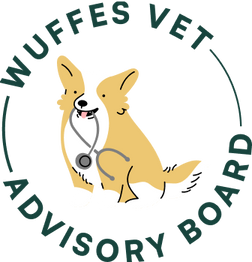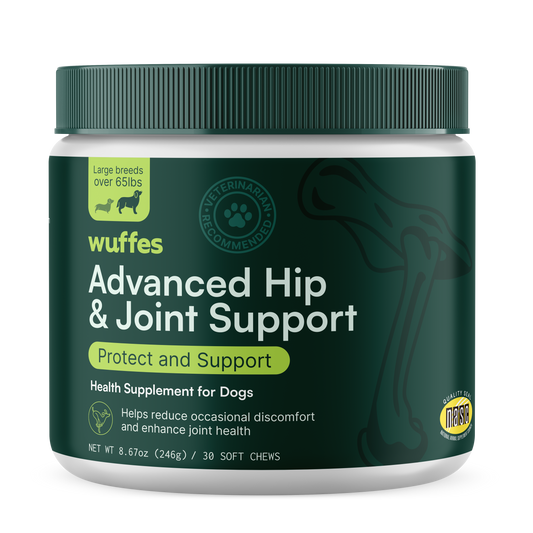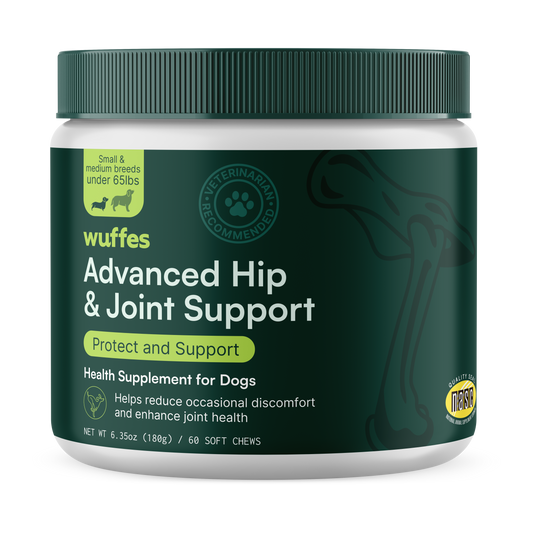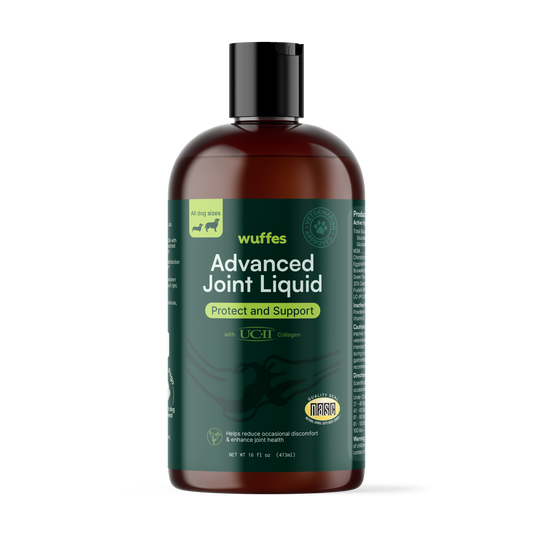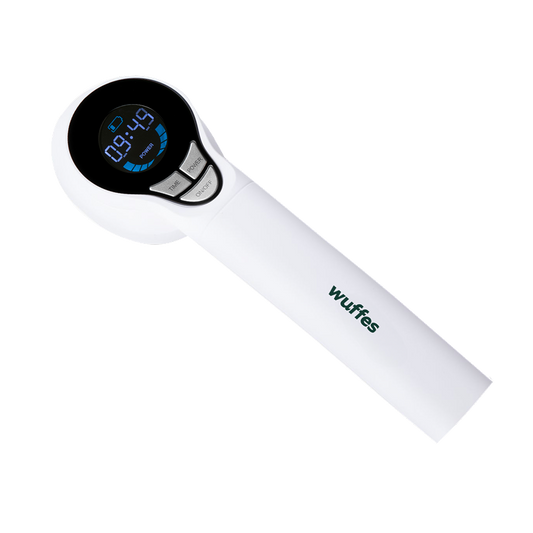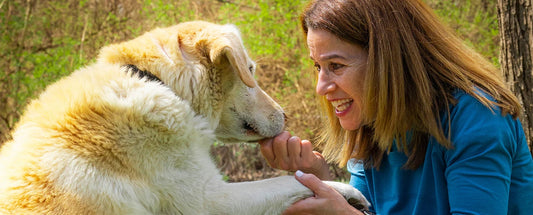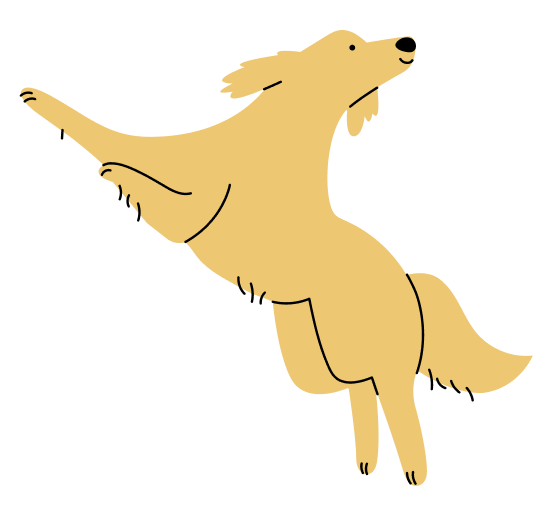There are many different causes of joint pain in dogs, just like in people. Some of these joint conditions can affect multiple joints, while others affect only 1 or 2 joints. It is important to determine the underlying cause of your dog’s joint pain so that the appropriate treatment(s) can be chosen, getting your dog back to an active, pain-free lifestyle!
Below are some common joint conditions in dogs and what you should know about them.
Conditions affecting multiple joints (polyarthropathy)
Osteoarthritis (‘Degenerative Joint Disease’)
Osteoarthritis, commonly referred to as arthritis, is the most common joint condition in dogs. However, in dogs, osteoarthritis is typically caused by another underlying joint condition. For instance, joint instability or incongruity secondary to abnormal joint development (eg: hip dysplasia) or a joint injury (eg: ligament tear) can be underlying causes.[1] Many of the below conditions can also cause osteoarthritis.
Symptoms include joint stiffness, lameness, and swelling within the joint. Diagnosis can be made through x-rays, though joint fluid analysis may also be necessary. Early intervention is crucial to slow progression and reduce symptoms. The cornerstones of osteoarthritis treatment in dogs include: maintaining an ideal body weight, regular exercise, anti-inflammatory medications, and supplements to support joint health.[1] Joint injections and targeted rehabilitation therapies may also be beneficial.[1]
Infectious/Inflammatory Polyarthropathy
There are some infections in dogs which can cause joints to become inflamed, in addition to causing other signs in the body, such as fever, reduced appetite, and lethargy. Some of the more common infections that can cause joint inflammation include bacterial infections from tick bites, such as Lyme Disease and Ehrlichia. Other infections can also spread to the joints through the blood, such as infections originating in the heart.[2]
Symptoms include joint swelling and pain, shifting leg lameness, reluctance to move, fever, lethargy, and decreased appetite. Diagnostics could include blood tests for tick borne infections, x-rays, joint fluid analysis, +/- ultrasound of the heart. Oral antibiotics can help clear active infection and anti-inflammatory medications can improve joint pain.[2]
Immune-Mediated Polyarthropathy (IMPA = ‘Rheumatoid Arthritis’ in People)
Similar to human rheumatoid arthritis, dogs can develop joint inflammation and swelling due to their immune systems damaging their joints. This can be initiated by an overreaction of the immune system to a new drug, vaccine, food, infection, or cancer, an inappropriate reaction to something normal within the body, or the cause may be unknown.[3]
Symptoms can include multiple swollen/painful joints (especially the wrists, ankles, and knees), reluctance to move, shifting leg lameness, lethargy, fever, and reduced appetite.[4] Diagnostics may include: x-rays, blood tests, urine tests and joint fluid analysis. Treatment requires immunosuppressive medications, which may be lifelong.[4] Dogs who are cured of their IMPA are expected to develop osteoarthritis, requiring continued management (see above).
Osteochondrosis (‘Osteochondritis dissecans’)
Osteochondrosis affects young, large dogs that grow rapidly. This condition interrupts the normal formation of cartilage and bone, leading to abnormal or detached joint cartilage.[5] This condition can lead to joint inflammation and osteoarthritis.
Symptoms include joint stiffness, lameness, and swelling within the joint (especially the shoulder, elbow, knee or ankle).[5] Diagnosis can be made through x-rays, CT or arthroscopy. Early intervention is crucial, which may include medical management or arthroscopic removal of the abnormal or detached cartilage.[5] Even if arthroscopic surgery is performed, osteoarthritis is expected to progress within the joint, requiring lifelong medical management (see above).
Conditions affecting 1-2 joints
Septic Arthritis
Septic arthritis occurs when bacteria infect a joint, due to infection elsewhere in the body (eg: urinary tract infection), previous joint surgery, or trauma. Septic arthritis can also be associated with other diseases (eg: diabetes) or medications (eg: immunosuppressives).[6]
Symptoms include severe joint swelling and pain, fever, loss of appetite, pain in the affected joint, stiffness, and lethargy. Diagnosis involves x-rays and analysis of joint fluid. Treatment includes antibiotics (oral +/- injected into the joint) and, in some cases, surgical intervention to remove infected surgical implants, damaged tissue and/or flush the joint cavity.[6] Pain medications help improve comfort while the infection is treated.
Joint Dysplasia (eg: Hip or Elbow Dysplasia)
Joint dysplasia is a developmental abnormality of the joint, which commonly affects the hips and elbows in dogs. This leads to abnormal forces placed on the cartilage and/or joint laxity, and ultimately osteoarthritis progression.[5]
Symptoms include lameness of the affected legs, joint pain, difficulty rising, and reluctance to run or play. X-rays or CT are diagnostic, and treatment often relies on medical management to limit osteoarthritis progression (see above). In some cases, surgical intervention may be recommended to improve joint alignment, remove cartilage fragments, or replace the joint completely.[5]
Kneecap Displacement (‘Patellar Luxation’)
Kneecap displacement, or patellar luxation, is typically a developmental condition affecting the kneecap's position, and less commonly a result of trauma. It causes abnormal biomechanics in the knee joint (abnormal knee extension), which can cause pain and difficulty in movement. Mild cases may allow the kneecap to return to its normal position, while severe cases can result in persistent displacement of the kneecap. This can lead to osteoarthritis of the knee and predispose to other knee injuries (eg: cranial cruciate ligament tears).[7]
Symptoms include hindlimb lameness, especially a skipping gait or intermittent lifting of the leg. Diagnosis is via physical examination and can be confirmed via x-rays. Treatment depends on the severity of displacement and can include medical management and rehabilitation, or may require surgery to correct the displacement.[7]
Cranial Cruciate Ligament Injury (= ‘ACL’ Tear in People)
Cranial cruciate ligament injuries (CCLI) are one of the most common causes of hindlimb lameness and knee pain in dogs. CCLI is often a degenerative condition, commonly affecting both knees, but traumatic injuries can also occur. Injury results in joint instability, inflammation, pain, and can result in meniscal damage.[8]
Symptoms include acute and significant hindlimb lameness, knee pain and swelling. Diagnosis includes physical examination, x-rays, +/- arthroscopy or other imaging techniques. Treatment can include surgical stabilization procedures and/or medical management to alleviate joint inflammation and pain, and slow progression of resultant knee osteoarthritis.[8]
Legge-Calvé-Perthes Disease (AKA Avascular Necrosis of the Femoral Head)
Legg-Calvé-Perthes disease, also known as avascular necrosis of the femoral head, is commonly seen in young small/miniature breed dogs. This condition involves a lack of blood supply to the femoral head (part of the hip joint), causing hip pain and eventual collapse of part of the hip joint. Trauma can predispose, but not in all cases.[5]
Symptoms include pain in the hip joint, hindlimb lameness, and hindlimb muscle atrophy. Diagnosis is typically confirmed through x-rays. Treatment usually involves surgical removal of the femoral head and neck, along with physical rehabilitation to aid in recovery of limb use.[5]
References
- Rychel JK. Diagnosis and treatment of osteoarthritis. Top Companion Anim Med. 2010 Feb;25(1):20-5. doi: 10.1053/j.tcam.2009.10.005. PMID: 20188335.
- Jacques D, Cauzinille L, Bouvy B, Dupre G. A retrospective study of 40 dogs with polyarthritis. Vet Surg. 2002 Sep-Oct;31(5):428-34. doi: 10.1053/jvet.2002.34665. PMID: 12209413.
- Johnson KC, Mackin A. Canine immune-mediated polyarthritis: part 1: pathophysiology. J Am Anim Hosp Assoc. 2012 Jan-Feb;48(1):12-7. doi: 10.5326/JAAHA-MS-5744. Epub 2011 Dec 21. PMID: 22190602.
- Johnson KC, Mackin A. Canine immune-mediated polyarthritis: part 2: diagnosis and treatment. J Am Anim Hosp Assoc. 2012 Mar-Apr;48(2):71-82. doi: 10.5326/JAAHA-MS-5756. Epub 2012 Jan 19. PMID: 22267168.
- Demko J, McLaughlin R. Developmental orthopedic disease. Vet Clin North Am Small Anim Pract. 2005 Sep;35(5):1111-35, v. doi: 10.1016/j.cvsm.2005.05.002. PMID: 16129135.
- Phillips TF, Bleyaert HF. Retrospective evaluation of 103 cases of septic arthritis in dogs. Vet Rec. 2022 Mar;190(5):e938. doi: 10.1002/vetr.938. Epub 2021 Sep 23. PMID: 34558080.
Dr. Erin Miscioscia, DVM DACVSMR CVA


